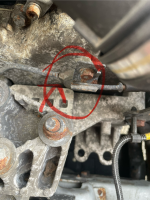Hi,
I'm having a bit of a Cain Dingle moment with my 64 plate (2014/15) Doblo 1.3 multijet.
All has been fine until fairly recently when I noticed that when I started the van it wouldn't rev past 3000rpm when stationary. However, once in gear and on the move it would accelerate rapidly and pull well.
That is until the other day when I was travelling down the A1, I stopped at the services but when I returned and started the van the EML appeared. I noticed that when I rejoined the A1 the van wouldn't accelerate very fast and would creep up to 3000rpm even with my foot to the floor, eventually it barely went above 3100rpm.
I initially suspected that it could be the air filter or MAF sensor (I had a similar experience with a Rover 25 Perkins diesel when the MAF was broken).
I uncoupled the sensor and gave the connections a blast of electrical cleaner. It didn't change anything. I then tried driving with the MAF uncoupled and that didn't make a difference.
I checked the air filter, and to be fair it needs replacing, but that didn't seem to be causing an issue.
So I dug out my cheap code reader and it came up with 'P2563 - Turbocharger Boost Control Position Sensor A Circuit Range / Performance'.
Seems like a done deal. However, I found this forum and read a few posts and it seemed like it could be a sticky wastegate actuator. I took the under body panels off, got a torch out and looked around but couldn't find it (I was following the 'sticky actuator' youtube video that was in another post).
Then I realised that it's very accessible and at the top of the turbo located just behind the radiator (picture attached). I sprayed with WD-40 but it wasn't seized at all.
That said, it does make a bit of a wheezing sound when I move the rod up and down, and when the engine is running the resistance is exactly the same as when the engine is off. Whether or not that is relevant, I do not know. Perhaps someone could shed some light?
Should it sound like I'm pumping up an airbed or rubber dinghy with one of those foot pumps you buy at the beach?
To confuse matters (for me at least) I have been searching online for a turbocharger boost control position sensor, but cannot find one. All of the search results are for pressure sensors, and it is my understanding that these two are not the same.
Therefore, does anyone know where I can buy the correct sensor from, and where it is located so I can change it?
Cheers
I'm having a bit of a Cain Dingle moment with my 64 plate (2014/15) Doblo 1.3 multijet.
All has been fine until fairly recently when I noticed that when I started the van it wouldn't rev past 3000rpm when stationary. However, once in gear and on the move it would accelerate rapidly and pull well.
That is until the other day when I was travelling down the A1, I stopped at the services but when I returned and started the van the EML appeared. I noticed that when I rejoined the A1 the van wouldn't accelerate very fast and would creep up to 3000rpm even with my foot to the floor, eventually it barely went above 3100rpm.
I initially suspected that it could be the air filter or MAF sensor (I had a similar experience with a Rover 25 Perkins diesel when the MAF was broken).
I uncoupled the sensor and gave the connections a blast of electrical cleaner. It didn't change anything. I then tried driving with the MAF uncoupled and that didn't make a difference.
I checked the air filter, and to be fair it needs replacing, but that didn't seem to be causing an issue.
So I dug out my cheap code reader and it came up with 'P2563 - Turbocharger Boost Control Position Sensor A Circuit Range / Performance'.
Seems like a done deal. However, I found this forum and read a few posts and it seemed like it could be a sticky wastegate actuator. I took the under body panels off, got a torch out and looked around but couldn't find it (I was following the 'sticky actuator' youtube video that was in another post).
Then I realised that it's very accessible and at the top of the turbo located just behind the radiator (picture attached). I sprayed with WD-40 but it wasn't seized at all.
That said, it does make a bit of a wheezing sound when I move the rod up and down, and when the engine is running the resistance is exactly the same as when the engine is off. Whether or not that is relevant, I do not know. Perhaps someone could shed some light?
Should it sound like I'm pumping up an airbed or rubber dinghy with one of those foot pumps you buy at the beach?
To confuse matters (for me at least) I have been searching online for a turbocharger boost control position sensor, but cannot find one. All of the search results are for pressure sensors, and it is my understanding that these two are not the same.
Therefore, does anyone know where I can buy the correct sensor from, and where it is located so I can change it?
Cheers
- Model
- 1.3 multijet
- Year
- 2014
- Mileage
- 121000



